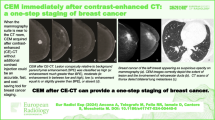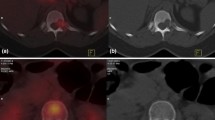Abstract
Purpose
Optimizing treatment strategies for patients with inflammatory breast cancer (IBC) relies on accurate initial staging. This study compared contrast-enhanced computed tomography (ce-CT) and FDG-PET/CT for initial staging of IBC to determine the frequency of discordance between the two imaging modalities and potential impact on management.
Methods
81 patients with IBC underwent FDG-PET/CT and ce-CT prior to starting treatment. FDG-PET/CT and ce-CT scans were independently reviewed for locoregional and distant metastases and findings recorded by anatomic site as negative, equivocal, or positive for breast cancer involvement. Each paired ce-CT and FDG-PET/CT case was classified as concordant or discordant for findings. Discordant findings were subclassified as (a) related to the presence or absence of distant metastases; (b) affecting the locoregional radiation therapy plan; or (c) due to incidental findings not related to IBC.
Results
There were 47 discordant findings between ce-CT and FDG-PET/CT in 41 of 81 patients (50.6%). Thirty (63.8%) were related to the presence or absence of distant metastases; most commonly disease detection on FDG-PET/CT but not ce-CT (n = 12). FDG-PET/CT suggested alterations of the locoregional radiation therapy plan designed by CT alone in 15 patients. FDG-PET/CT correctly characterized 5 of 7 findings equivocal for metastatic IBC on ce-CT.
Conclusions
This study demonstrates differences between ce-CT and FDG-PET/CT for initial staging of IBC and how these differences potentially affect patient management. Preliminary data suggest that FDG-PET/CT may be the imaging modality of choice for initial staging of IBC. Prospective trials testing initial staging with FDG-PET/CT versus important clinical end-points in IBC are warranted.


Similar content being viewed by others
References
Matro JM, Li T, Cristofanilli M et al (2015) Inflammatory breast cancer management in the national comprehensive cancer network: the disease, recurrence pattern, and outcome. Clin Breast Cancer 15:1–7
Warren LE, Guo H, Regan MM et al (2015) Inflammatory breast cancer: patterns of failure and the case for aggressive locoregional management. Ann Surg Oncol 22:2483–2491
Ueno NT, Buzdar AU, Singletary SE et al (1997) Combined-modality treatment of inflammatory breast carcinoma: twenty years of experience at M. D. Anderson Cancer Center. Cancer Chemother Pharmacol 40:321–329
Gradishar WJ, Anderson BO, Balassanian R et al (2017) NCCN guidelines insights: breast cancer, version 1.2017. J Natl Compr Canc Netw 15:433–451
Ueno NT, Espinosa Fernandez JR, Cristofanilli M et al (2018) International consensus on the clinical management of inflammatory breast cancer from the Morgan Welch inflammatory breast cancer research program 10th anniversary conference. J Cancer 9:1437–1447
Alberini JL, Lerebours F, Wartski M et al (2009) 18F-fluorodeoxyglucose positron emission tomography/computed tomography (FDG-PET/CT) imaging in the staging and prognosis of inflammatory breast cancer. Cancer 115:5038–5047
Baslaim MM, Bakheet SM, Bakheet R, Ezzat A, El-Foudeh M, Tulbah A (2003) 18-Fluorodeoxyglucose-positron emission tomography in inflammatory breast cancer. World J Surg 27:1099–1104
Carkaci S, Adrada BE, Rohren E et al (2012) Semiquantitative analysis of maximum standardized uptake values of regional lymph nodes in inflammatory breast cancer: is there a reliable threshold for differentiating benign from malignant? Acad Radiol 19:535–541
Carkaci S, Macapinlac HA, Cristofanilli M et al (2009) Retrospective study of 18F-FDG PET/CT in the diagnosis of inflammatory breast cancer: preliminary data. J Nucl Med 50:231–238
Yang WT, Le-Petross HT, Macapinlac H et al (2008) Inflammatory breast cancer: PET/CT, MRI, mammography, and sonography findings. Breast Cancer Res Treat 109:417–426
Walker GV, Niikura N, Yang W et al (2012) Pretreatment staging positron emission tomography/computed tomography in patients with inflammatory breast cancer influences radiation treatment field designs. Int J Radiat Oncol Biol Phys 83:1381–1386
Groheux D, Giacchetti S, Delord M et al (2013) 18F-FDG PET/CT in staging patients with locally advanced or inflammatory breast cancer: comparison to conventional staging. J Nucl Med 54:5–11
Hillner BE, Tosteson AN, Song Y et al (2012) Growth in the use of PET for six cancer types after coverage by medicare: additive or replacement? J Am Coll Radiol 9:33–41
Scheid V, Buzdar AU, Smith TL, Hortobagyi GN (1986) Clinical course of breast cancer patients with osseous metastasis treated with combination chemotherapy. Cancer 58:2589–2593
Woodward WAKE, Taklar V (2014) Radiation therapy for inflammatory breast cancer: technical considerations and diverse clinical scenarios. Fut Med 3:43–52
Woodward WA (2014) Postmastectomy radiation therapy for inflammatory breast cancer: is more better? Int J Radiat Oncol Biol Phys 89:1004–1005
Funding
The authors received no funding for this work.
Author information
Authors and Affiliations
Corresponding author
Ethics declarations
Conflict of interest
Heather Jacene has received honoraria from Janssen Pharmaceuticals, Bayer Healthcare; research support from Siemens Healthcare, Inc, GTx, Inc; and consulting from Advanced Accelerator Applications. Beth Overmoyer has received clinical trial support from Genentech, Incyte, GTx, and Eisai. All other authors have no declarations of interest.
Statement of human rights
This was a retrospective study involving data from human participants. All procedures performed in studies involving human participants were in accordance with the ethical standards of the institutional and/or national research committee (Dana-Farber/Harvard Cancer Center Institutional Review Boards; DFCI 12-156) and with the 1964 Helsinki declaration and its later amendments or comparable ethical standards.
Informed consent
This was a retrospective study and the requirement for informed consent was waived by the Dana-Farber/Harvard Cancer Center Institutional Review Board (DFCI clinical trial number 12-156).
Additional information
Publisher's Note
Springer Nature remains neutral with regard to jurisdictional claims in published maps and institutional affiliations.
Rights and permissions
About this article
Cite this article
Jacene, H.A., DiPiro, P.J., Bellon, J. et al. Discrepancy between FDG-PET/CT and contrast-enhanced CT in the staging of patients with inflammatory breast cancer: implications for treatment planning. Breast Cancer Res Treat 181, 383–390 (2020). https://doi.org/10.1007/s10549-020-05631-4
Received:
Accepted:
Published:
Issue Date:
DOI: https://doi.org/10.1007/s10549-020-05631-4




